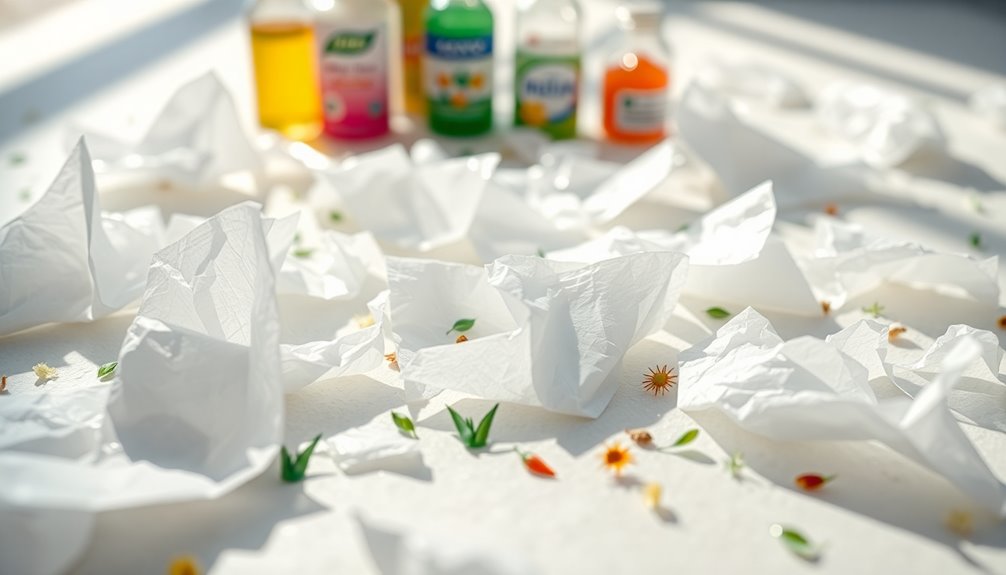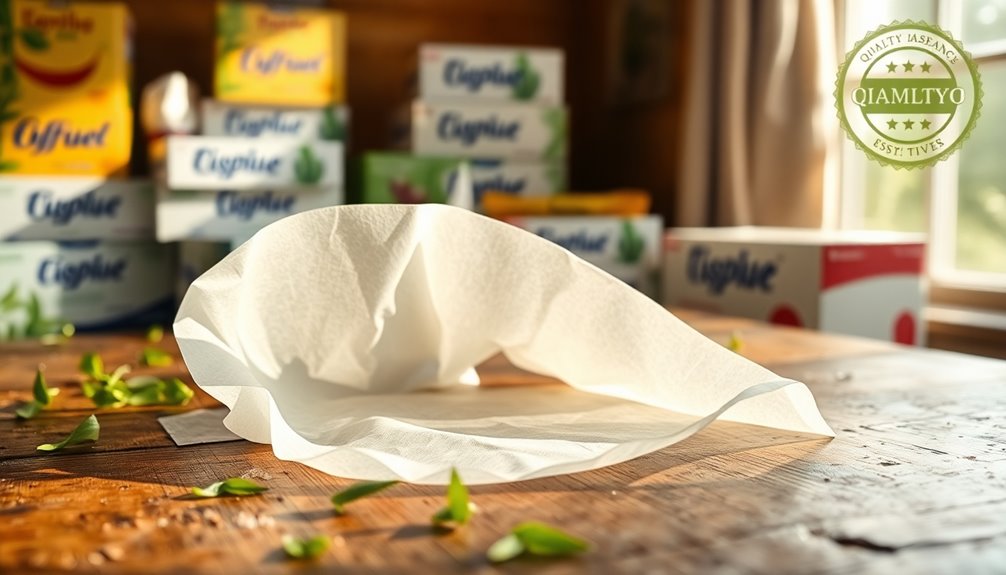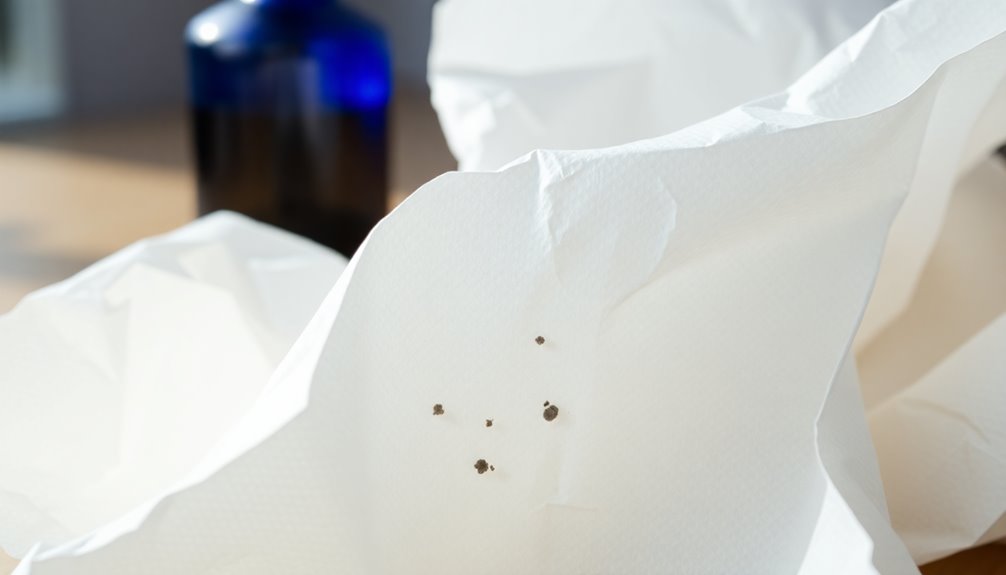Tissue papers are often made from an unexpected mix of materials. You might be surprised to find recycled paper at play, but there's more. Many brands contain harmful additives like chlorine, phthalates, and even bisphenols from thermal receipts. Some tissues also feature scents with undisclosed chemicals. Even more alarming, recent studies have detected PFAS, substances linked to health risks. This combination raises questions about what you're really using. If you're curious about safer alternatives and the impacts of your choices, there's more to uncover about this commonplace product.
Key Takeaways
- Tissue papers often contain recycled materials, which may introduce harmful bisphenols from thermal receipts.
- Some brands use harsh chemicals like formaldehyde and chlorine during processing, posing health risks.
- Scented tissues can include undisclosed fragrances, synthetic musks, and phthalates that may affect health.
- Bleaching processes often involve chlorine compounds, which can produce harmful dioxins linked to illnesses.
- Recent studies have detected PFAS chemicals in certain tissue products, raising environmental and health concerns.
Surprising Ingredients in Tissues

When you grab a tissue, you might assume it's just made from soft cellulose fibers, but there are surprising ingredients lurking beneath the surface. Tissue papers often contain recycled paper, which can introduce unexpected ingredients like bisphenols from thermal receipts. You might not realize that some brands of toilet paper and tissues use harsh chemicals during processing, including formaldehyde and chlorine. These chemicals can pose health risks, particularly with repeated exposure.
Scented tissues can be especially tricky, as they often contain undisclosed fragrances that may include synthetic musks and phthalates, raising safety concerns. Moreover, the bleaching process for these tissues frequently involves chlorine compounds, which can produce dioxins linked to serious health issues. And if that's not enough, recent studies have detected PFA (per- and polyfluoroalkyl substances) in certain tissue products, further highlighting the unexpected ingredients hiding in your everyday items.
If you're concerned about the materials in your tissues, consider looking for products certified by the Forest Stewardship Council (FSC) to ensure a more environmentally responsible choice. It's worth knowing what goes into the products you use daily!
Environmental Impact of Tissues

Tissue papers often have a significant environmental impact, contributing to deforestation and pollution at alarming rates. Conventional toilet paper use is a major culprit, with Americans consuming nearly 8 million tons each year, leading to substantial environmental waste. The pulp and paper industry is responsible for about 15% of global deforestation, resulting in the loss of millions of trees annually.
Producing tissue papers requires vast amounts of resources, including approximately 37 gallons of water for just one roll of toilet paper. The process often involves harmful bleaching techniques that release toxic chemicals like dioxins into waterways, adversely affecting aquatic ecosystems. Furthermore, standard tissue paper can take years to decompose, and the plastic packaging used in distribution adds to long-term landfill waste.
Switching to recycled toilet paper can help mitigate these issues by reducing the demand for wood pulp and promoting sustainable forestry practices. By being mindful of your choices, you can significantly lessen your environmental footprint and encourage a healthier planet. It's time to consider the true cost of your tissue paper use and explore more sustainable options for a greener future.
Choose Unbleached Paper Products

Choosing unbleached paper products not only benefits the environment but also promotes healthier options for you and your family. Unbleached tissue paper retains its natural color, avoiding harmful bleaching agents like chlorine that can release toxic dioxins into our ecosystems. By opting for unbleached products, you help reduce chemical exposure, especially for sensitive skin.
Many unbleached paper products are crafted from recycled materials, making them environmentally friendly and reducing deforestation. This sustainable production approach minimizes the ecological footprint associated with paper manufacturing. Furthermore, unbleached paper is often processed with fewer additives, resulting in a biodegradable product that decomposes naturally without contributing to landfill waste.
When you choose unbleached tissue papers and personal care products, you're also supporting brands that often carry eco-labeling certifications. These labels ensure that the products meet specific environmental standards, giving you peace of mind about your choices. By switching to unbleached options, you take an important step toward a healthier home and a cleaner planet.
Health Risks of Additives

Additives in tissue papers can pose significant health risks, especially for those with sensitive skin. Many toilet paper products contain chlorine, a chemical linked to irritation and potential carcinogenic effects. If you're using these products regularly, you could face health concerns like chronic discomfort, particularly if they include formaldehyde.
Scented tissue papers and flushable wipes often have undisclosed fragrances that may contain synthetic musks and phthalates, both of which can be harmful. The polyethylene glycol (PEG) compounds in some wipes can leave behind carcinogens due to their ethoxylation process, raising worries about long-term exposure. Additionally, paraffin wax found in certain tissue products can be absorbed through the skin and may carry carcinogenic properties, increasing your risk further.
With the potential presence of these harmful additives, it's crucial to read labels carefully and consider the health implications of the products you choose. Being aware of these risks can help you make informed decisions and protect your skin from unnecessary irritation and exposure to toxic substances.
Consumer Reports on Tissue Brands

With growing concerns over the health risks posed by harmful additives in tissue products, many consumers are seeking safer alternatives. A recent Consumer Reports investigation revealed that 24% of tested toilet paper products contained PFAS chemicals, raising red flags about the safety of popular brands. You might be surprised to learn that some well-known options, like Charmin Ultra and Seventh Generation 100% Recycled, showed detectable levels of organic fluorine, which could indicate potential health risks.
On the flip side, brands such as Bambootiful, Brandless, and Kirkland Signature are stepping up by using safer processing methods, resulting in lower PFAS levels. If you're particularly concerned about chemical exposure, consider products like Angel Soft and Cottonelle Mega Ultra, which exhibited no detectable PFAS. This highlights the growing importance of consumer awareness regarding the ingredients in your tissue products. Additionally, like air purifiers, choosing products with effective filtration can contribute to a healthier home environment by reducing harmful substances.
As you make choices for your household, prioritize brands that emphasize transparency and safety. Look for toilet paper made from sustainable materials like bamboo or responsibly sourced wood. By staying informed, you can choose products that align with your health and environmental values.
Tissues Contain Harmful Additives

When you reach for a tissue, you might not realize that many products contain harmful additives that can pose health risks. For instance, chlorine is commonly used in the bleaching process, which has been linked to irritation and even increased cancer risks. You may also encounter formaldehyde in some tissues, leading to chronic irritation in sensitive areas.
Scented tissues and flushable wipes often contain undisclosed harmful ingredients, like synthetic musks and phthalates, which can jeopardize your health. Additionally, certain wipes may include polyethylene glycol (PEG) compounds that leave behind carcinogenic residues due to their ethoxylation process. This makes it crucial to scrutinize the ingredients.
Many commercial tissues also include paraffin wax, which can be absorbed through the skin and carries carcinogenic properties. The next time you consider which toilet paper to purchase, remember that even tissues can harbor harmful additives. By staying informed, you can make safer choices for your health and well-being. Always check the labels and opt for brands that prioritize ingredient safety.
Frequently Asked Questions
What Are Tissue Papers Made Of?
When you grab a tissue, you might not realize it's primarily made from cellulose, derived from wood pulp. This natural polymer gives tissue its softness and strength. Many companies use recycled paper to produce tissue, helping reduce waste and deforestation. Some eco-friendly options even incorporate materials like bamboo or sugarcane. Additionally, calcium carbonate can be added to enhance durability, making your tissue not only useful but also environmentally conscious.
What Toilet Paper Does Not Contain Chemicals?
If you're looking for toilet paper that doesn't contain chemicals, opt for brands that emphasize eco-friendliness. Products made from 100% bamboo or recycled paper are often free from harmful additives. Look for organic options, as they typically avoid chlorine bleach, fragrances, and dyes, making them safer for sensitive skin. Brands like Who Gives a Crap and Caboo proudly market their non-toxic compositions, so you can feel good about your choice.
What Is the Ingredient of Tissue Paper?
When you look at tissue paper, you might think it's just simple and soft. However, it's primarily made from cellulose, derived from wood pulp. You'll often find recycled paper in the mix, which gets pulped with warm water. Sometimes, manufacturers add calcium carbonate for added strength. Be aware, though, that certain unexpected ingredients, like PFAS, can sneak in during production, raising concerns about environmental impact.
Is There Any Chemical in Tissue Paper?
Yes, there are chemicals in tissue paper. You might find harmful substances like chlorine used in the bleaching process, which can irritate your skin and pose health risks. Additionally, some recycled tissue paper may contain bisphenols, like BPA, that disrupt hormones. Unlisted fragrances and additives can also lead to allergic reactions. It's essential to check labels and choose products with fewer chemicals to protect yourself from potential irritants.










